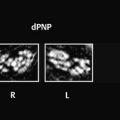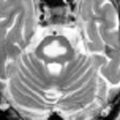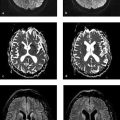Brain Tumors
3.1 Introduction
Various criteria can be used in the classification of intracranial tumors. It is common, for example, to classify brain tumors by their location: supratentorial tumors, infratentorial tumors, and tumors of the sellar region or skull base. Another method, relevant to surgical treatment, is to classify brain tumors as intra-axial or extra-axial, i.e., tumors that are external to the brain parenchyma or tumors that arise within the brain substance from glial and neuronal cells. Of course, some tumors undergo both intra-axial and extra-axial growth, so this classification is not always definitive. The classification of brain tumors used in this chapter is based on neuropathologic aspects. This is done to ensure complete coverage of clinically relevant tumors and also to avoid excessive duplication with tumors that may show infratentorial as well as supratentorial growth, for example. This classification and the descriptions in this chapter provide a very rigorous scheme for classifying the various brain tumors. This schematic approach is also consistent with the primary concept of this book, which will likely be used more for reference than for casual reading ( ▶ Table 3.1).
Designation | WHO grade | ||
Tumors of neuroepithelial tissue | |||
Astrocytic tumors | Pilocytic astrocytoma | I | |
| II | ||
Subependymal giant cell astrocytoma | I | ||
Pleomorphic xanthoastrocytoma | II, III | ||
Diffuse astrocytoma | II | ||
| II | ||
| II | ||
| II | ||
Anaplastic astrocytoma | III | ||
Glioblastoma (multiforme) | IV | ||
| IV | ||
| IV | ||
Gliomatosis cerebri | III, IV | ||
Oligodendroglial tumors | Oligodendroglioma | II | |
Anaplastic oligodendroglioma | III | ||
Oligoastrocytic tumors | Oligoastrocytoma | II | |
Anaplastic oligoastrocytoma | III | ||
Ependymal tumors | Subependymoma | I, II | |
Myxopapillary ependymoma | I | ||
Ependymomas | II | ||
| II | ||
| II | ||
| II | ||
| II | ||
Anaplastic ependymoma | III | ||
Choroid plexus tumors | Choroid plexus papilloma | I | |
Atypical choroid plexus papilloma | II | ||
Choroid plexus carcinoma | III | ||
Neuroepithelial tumors of uncertain origin | Astroblastoma | II, III | |
Chordoid glioma of the third ventricle | II | ||
Angiocentric glioma | I | ||
Neuronal and mixed neuronal-glial tumors | Dysplastic gangliocytoma of the cerebellum | I | |
Desmoplastic infantile astrocytoma/ganglioglioma | I | ||
Dysembryoplastic neuroepithelial tumor | I | ||
Gangliocytoma | I | ||
Ganglioglioma | I, II | ||
Anaplastic ganglioglioma | III | ||
Central neurocytoma | II | ||
II | |||
Cerebellar liponeurocytoma | I, II | ||
Papillary glioneuronal tumor | I | ||
Rosette-forming glioneuronal tumor | I | ||
Paraganglioma | I | ||
Tumors of the pineal region | Pineocytoma | I | |
Pineal parenchymal tumor of intermediate differentiation | II, III | ||
Papillary tumor of the pineal region | II, III | ||
Pineoblastoma | IV | ||
Embryonal tumors | Medulloblastoma | IV | |
| IV | ||
| IV | ||
| IV | ||
| IV | ||
Primitive neuroectodermal tumors | IV | ||
| IV | ||
| IV | ||
| IV | ||
| IV | ||
Atypical teratoid/rhabdoid tumor | IV | ||
Tumors of the cranial and paraspinal nerves | |||
Schwannoma (neurinoma) | I | ||
| I | ||
| I | ||
| I | ||
Neurofibroma | I | ||
| I | ||
Perineurioma | I—III | ||
| I, II | ||
| III | ||
Malignant peripheral nerve sheath tumor (MPNST) | III, IV | ||
| III, IV | ||
| III, IV | ||
| III, IV | ||
Tumors of the meninges | |||
Tumors of meningothelial cells | Meningioma | I | |
| I | ||
| I | ||
| I | ||
| I | ||
| I | ||
| I | ||
| I | ||
| I | ||
| I | ||
| II | ||
| II | ||
| II | ||
| II, III | ||
| III | ||
| III | ||
Mesenchymal tumors | Lipoma | ||
Angiolipoma | |||
Hibermoma | |||
Liposarcoma | |||
Solitary fibrous tumor | |||
Fibrosarcoma | |||
Malignant fibrous histiocytoma | |||
Leiomyoma | |||
Leiomyosarcoma | |||
Rhabdomyoma | |||
Rhabdomyosarcoma | |||
Chondroma | |||
Chondrosarcoma | |||
Osteoma | |||
Osteosarcoma | |||
Osteochondroma | |||
Hemangioma | I | ||
Epithelioid hemangioendothelioma | |||
Hemangiopericytoma | II | ||
Anaplastic hemangiopericytoma | III | ||
Angiosarcoma | |||
Kaposi sarcoma | |||
Ewing sarcoma | |||
Primary melanocytic lesions | Diffuse melanocytosis | I | |
Melanocytoma | I | ||
Malignant melanoma | III, IV | ||
Meningeal melanomatosis | III, IV | ||
Other neoplasms related to the meninges | Hemangioblastoma | I | |
Lymphomas and hematopoietic neoplasms | |||
Malignant lymphoma | |||
Plasmacytoma | |||
Granulocytic sarcoma | |||
Germ cell tumors | |||
Germinoma | II, III | ||
Embryonal carcinoma | IV | ||
Yolk sac tumor | IV | ||
Choriocarcinoma | IV | ||
Teratoma | I—IV | ||
| |||
| |||
| |||
Mixed germ cell tumor | II—IV | ||
Tumors of the sellar region | |||
Craniopharyngioma | I | ||
| I | ||
| I | ||
Granular cell tumor | I | ||
Pituicytoma | I | ||
Spindle-cell oncocytoma of the adenohypophysis | I | ||
Rhabdomyoma | |||
Metastatic tumors | IV | ||
Source: Louis DN, Ohgaki H, Wiestler OD et al. The 2007 WHO classification of tumours of the central nervous system. Acta Neuropathol 2007;114 (2):97–109, erratum: Acta Neuropathol 2007;114(5):547. | |||
It is also true, however, that a range of classifications will greatly help the diagnostician in interpreting images and narrowing the differential diagnosis to one possible tumor entity. The general classification of a detected tumor as intra-axial or extra-axial will in itself greatly narrow the differential diagnosis. Further investigation of the underlying histology of a tumor will then rely on auxiliary parameters such as an infra- or supratentorial location and the age and sex of the patient. Close attention to the reaction of surrounding anatomic structures, such as the calvarium, or the reaction of the brain tissue to the tumor, will supply useful information on the growth rate and biologic behavior of a tumor and thus on whether it is benign or malignant. There is also is the principle of narrowing the diagnosis based on tumor frequency, as there is simply a greater chance of encountering a common tumor than a rare one.









